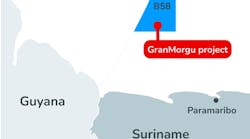Units destined for marginal shallow water fields
Nick Terdre
Contributing Editor
Tankers, such as the one shown, are in demand for conversion to FSO and FPSO service.A five-year contract to supply a floating production unit for a field development in Nigeria is the latest in a growing list of references for the provision of offshore production facilities built up by Fred Olsen Production (FOP) in West Africa.
Addax Petroleum will lease the contractor's Suezmax tanker Knock Taggart to develop reserves on the OPL 098 licence off Nigeria. The vessel will be upgraded to an FPSO equipped with a 30,000 b/d processing facility. FOP has contracted the Expro Group of the UK to provide and operate the processing facility.
When the contract with Addax was being negotiated, the vessel, which has one million bbl storage capacity, was already working a five-year charter as a floating storage and offloading (FSO) unit on Abacan Resource's IMA Field in block 469, also in Nigeria. A settlement agreement to terminate this contract was signed in September.
FOP is part of the Fred Olsen Energy group which also operates mobile drilling rigs, and whose Harland & Wolff yard built the FPSO for BP's Schiehallion development west of the Shetlands. The firm has a number of other vessels engaged in shallow water production in West Africa. The latest to come on stream is Petroleo Nautipa which is working as a floating production, storage and offloading (FPSO) vessel on Ranger's Kiame Field in block 4 in Angola.
Suezmax tankers
Converted from Knock Buie, another Suezmax tanker built in 1974, Petroleo Nautipa began producing under a four-year contract in June, less than a year after the contract was signed. With reserves estimated at 8 million bbl, Kiame is among the smallest fields developed with stand-alone facilities. Production, which is expected to peak at 7,000-9,000 b/d, is through two existing wells recompleted as horizontal multilateral producers.Conversion of the vessel took place over an 11-month period at the Keppel yard in Singapore. This project saw Fred Olsen form a joint venture with another Norwegian company, Nortrans Offshore, which was responsible for provision of the processing equipment. The vessel is moored in 142 meters water depth by eight mooring legs.
There are a number of benefits for marginal field development in conventional water depths in benign-climate areas such as West Africa, explains managing director, Georg Sverdrup Onsrud. With older tankers in low demand for oil transport, converting an existing hull is an attractive option. The company itself operates a number of Suezmax tankers which are suitable for conversion.
An FPSO provides processing and storage facilities in one unit. As conventional spread moorings can be used, the cost and time of conversion is kept down compared with the turret-moored FPSO required in harsher en viron ments such as the North Sea. The Knock Taggart conversion will cost $20 million. The conversion period is also short - Knock Taggart is due to commence its charter party next January.
The terms of the operating lease can be arranged to align the interests of field owners and FPSO contractor, for example, through a tariff incentive scheme based on the production level, which enables the contractor to take a lower day-rate and the field owners to reduce their up-front cost commitment. In the case of the Kiame contract, FOP is receiving a day-rate of $35,000, which over the fixed contract period works out at some $50 million.
In a joint venture with Schlumberger, FOP is also playing a role in South Africa's first offshore oil development. The converted tanker Knock Dee, which has storage capacity of 950,000 bbl, is in the second year of a four-year charter providing combined storage and shuttle tanker services on the Oribi Field. Loading is through a CALM buoy which has also been provided by FOP.
Under another joint venture with Schlum berger, FOP recently complted a contract providing production services to Mobil on the Isobo Field in Nigeria. In this case the production unit was not a floater but the company's jackup rig, Borgen Dolphin, fitted with 30,000 b/d processing facilities. This project took less than six months from contract award to first oil.
In West Africa as elsewhere it is often a requirement for contractors to facilitate financing, and this FOP is also generally able to do. For the lease of the Kiame FPSO, for example, it was able to arrange financing through Den Norske Bank. FOP also participates in Norway's Intsok, the joint industry/government movement to build relationships with other countries with offshore sectors which might benefit from Norwegian expertise. Relative to this, FOP, Onsrud gave a paper on operating leased production systems to a joint Norwegian/Angolan seminar seeking to match Norway's expertise with Angola's offshore requirements.
Copyright 1998 Oil & Gas Journal. All Rights Reserved.


